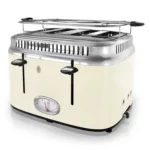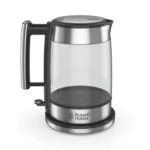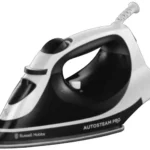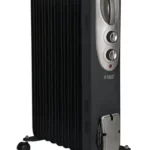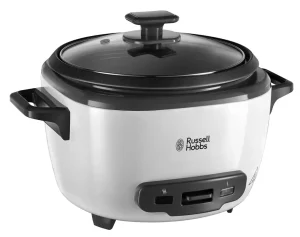
 27040-56 Electric Rice Cooker
27040-56 Electric Rice Cooker
User Manual
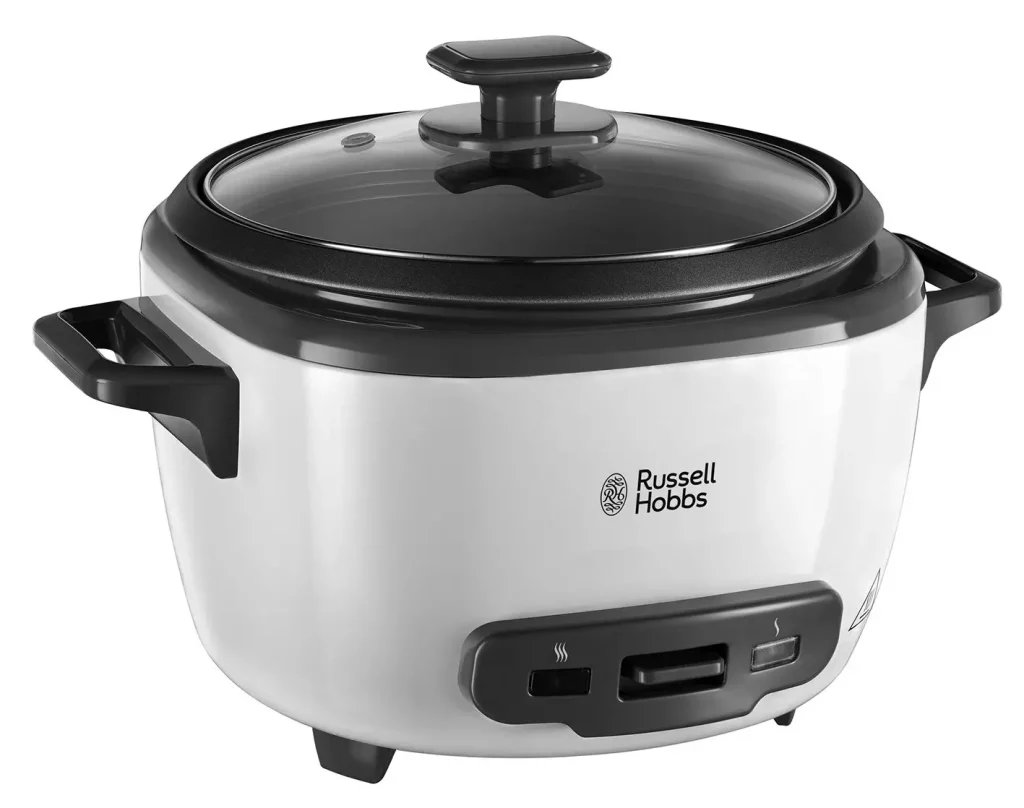

Read the instructions, keep them safe, pass them on if you pass the appliance on. Remove all packaging before use.
IMPORTANT SAFEGUARDS
Follow basic safety precautions, including:
This appliance can be used by children aged from 8 years and above and persons with reduced physical, sensory or mental capabilities or lack of experience and knowledge if they have been supervised/instructed and understand the hazards involved. Children shall not play with the appliance. Cleaning and user maintenance shall not be done by children unless they are older than 8 and supervised. Keep the appliance and cable out of reach of children under 8 years.
If the cable is damaged, it must be replaced by the manufacturer, its service agent, or someone similarly qualified, to avoid a hazard.
 The surfaces of the appliance will get hot.
The surfaces of the appliance will get hot.
 Do not use this appliance near bathtubs, showers, basins or other vessels containing water.
Do not use this appliance near bathtubs, showers, basins or other vessels containing water.
- Don’t put frozen meat or poultry in the appliance – defrost fully before use.
- Cook meat, poultry, and derivatives (mince, burgers, etc.) till the juices run clear. Cook fish till the flesh is opaque throughout.
- Don’t try to cook anything in the body of the cooker – cook only in the removable bowl.
- Don’t reach over the appliance, and keep hands, arms, face, etc. clear of the escaping steam.
- Fill with at least 1 cup of water.
- Don’t fill above the top of the fill mark.
- Don’t cover the appliance or put anything on top of it.
- Unplug the appliance when not in use.
- Don’t use accessories or attachments other than those we supply.
- Don’t use the appliance for any purpose other than those described in these instructions.
- Don’t use the appliance if it’s damaged or malfunctions.
HOUSEHOLD USE ONLY
PARTS
| 1. Knob 2. Lid 3. Basket 4. Fill mark 5. Bowl 6. Switch |
7. Lights 8. Spatula 9. Measuring cup 10. On/off switch |
BEFORE USING FOR THE FIRST TIME
Wash the bowl, lid, and basket in warm soapy water, rinse and dry
PREPARATION
- Sit the appliance on a stable, level, heat-resistant surface, near a power socket.
- Don’t use the appliance near or below curtains, shelves, cupboards, or anything else likely to be damaged by the escaping steam.
- Have oven gloves (or a cloth) to hand, and a heat-resistant mat or dinner plate to put the bowl on after cooking.
- Put the bowl inside the cooker.
COOKING
- Use the measuring cup to put the rice into the bowl.
- Fill the bowl with water up to the number corresponding to the number of cups of rice used.
- Give the bowl quarter of a turn each way, to ensure the bottom of the bowl makes good contact with the element.
- Put the lid on the bowl.
- Put the plug into the power socket. Move the on/off switch to I. Move the switch to the N position.
The N light will come on. - Move the switch to P. The N light will go out.
- When the rice is cooked, the switch will move to N, the Plight will go out, and the N light will come on.
- Let the rice rest for about 10 minutes, then unplug the cooker.
- Put on the oven gloves.
- Steam and hot air will escape when you lift the lid. Tilt it slightly to direct the steam away from you.
- Lift out the bowl and set it down on a heat-resistant mat or dinner plate.
- Use the spatula to turn and mix the rice, to let all the steam escape.
- Sometimes the layer of rice in contact with the bowl will form a crust.
- If you don’t want it you can remove it with the spatula, after you’ve served the rice.
ADDITIONAL INGREDIENTS
- If you add any additional ingredients (raisins, fruit, nuts, etc.), you should reduce the amount of rice to compensate for the amount of water they’ll absorb.
- Raisins and dried fruit will absorb as much water as rice, so put them into the measuring cup along with the rice.
- Nuts won’t generally absorb much water, so you can normally add them after you’ve measured the rice.
USING THE COOKER AS A STEAMER
- Add the required amount of water – Use method 1 or 2 above.
- Put the basket on top of the bowl and put the food into the basket.
- For uniform cooking, cut all pieces of food to roughly the same size.
- For peas, or anything that’ll break up or drop into the water, make a parcel with aluminum foil.
- Take care when removing the parcel – wear oven gloves and use plastic tongs/spoons.
- Put the lid on top of the basket.
- Operate the cooker the same way you would when cooking rice.
- Follow the steaming times.
- Don’t leave food in the cooker after steaming – it’ll go soggy.
- Note the type and quantity of food and the amount of water. Next time, adjust the amount of water and let the cooker look after the timing.
FINISHED?
- Switch off the appliance and unplug it.
- Don’t move the rice cooker with the full bowl inside it. It will be heavy, and the cable may catch on something as you move.
- Remove the bowl from the rice cooker before emptying it. If you try to remove food from the bowl while it’s in the rice cooker, you may spill the contents into the rice cooker. This will damage it.
CARE AND MAINTENANCE
- Switch off the appliance, unplug it and let it cool.
- Wash the lid, bowl, and rack in warm, soapy water, rinse and dry.
- Wipe all surfaces with a clean damp cloth.
 You may wash these parts in a dishwasher.
You may wash these parts in a dishwasher.
COOKING TIMES AND FOOD SAFETY
| food (fresh) | quantity | time (minutes) |
| asparagus | 400g | 15-18 |
| green beans | 200g | 20 |
| broccoli | 200g | 18 |
| brussels sprouts | 200g | 20 |
| cabbage (quarter) | 25-30 | |
| carrots (sliced) | 200g | 15-20 |
| cauliflower | 200g | 15 |
| corn cobs | 2 | 24-35 |
| courgette (sliced) | 200g | 10-12 |
| potatoes (quartered) | 400g | 25-30 |
| spinach | 200g | 5-8 |
| chicken (boneless) | 400g | 6-8 |
| fish fillets | 400g | 8-10 |
| fish steaks | 2 | 20-23 |
| prawns | 250g | 10-12 |
| lobster tail (frozen) | 12-15 | |
| mussels | 250g | 15 |
- Don’t use mussels that are open prior to cooking. Steam until the shells open fully, and discard any that aren’t open after cooking.
- These times are for a single layer of food. You’ll need to experiment to find the times which suit your favorite foods and food combinations.
- Cook meat, poultry, and derivatives (mince, burgers, etc.) till the juices run clear. Cook fish till the flesh is opaque throughout.
- You should cook leaf vegetables as little as possible, to keep them green and crisp. Plunging them into iced water will stop the cooking process.
RECYCLING
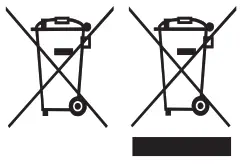 To avoid environmental and health problems due to hazardous substances, appliances and rechargeable and non-rechargeable batteries marked with one of these symbols must not be disposed of with unsorted municipal waste. Always dispose of electrical and electronic products and, where applicable, rechargeable and non-rechargeable batteries, at an appropriate official recycling/collection point.
To avoid environmental and health problems due to hazardous substances, appliances and rechargeable and non-rechargeable batteries marked with one of these symbols must not be disposed of with unsorted municipal waste. Always dispose of electrical and electronic products and, where applicable, rechargeable and non-rechargeable batteries, at an appropriate official recycling/collection point.
